The yellow tang (Zebrasoma flavescens) is one of the most common saltwater fish due to its striking color, fantastic shape, bold personality, and relative ease of care. They can add a pop of vibrant yellow and “frenzied reef fish” motion we all love to even an already bright reef tank.
But before we dive into the topic, I need your help. Will you share your experiences with this fish? My goal is to collect at least 100 responses to help provide some real-world evidence about the care of the Yellow tang in a home aquarium. The survey takes less than 5 minutes and once you submit, you’ll have access to the results before I’m even able to publish them broadly.
Please share your experiences with the community.
Table of Contents: Yellow Tang Care
Once you see that brilliant yellow shade on the flattened body, you’ll find yourself hooked on yellow tangs. And if you’re looking for a particular element of their care, you can use the links below to help you navigate through the article. But if you want the full appreciation of these nifty members of the surgeonfish group? You’ll probably want to read the entire thing. (Trust me, it’s worth it!)
- Introduction
- Quick Facts
- Natural Habitat of the Yellow Tang
- Yellow Tang Tank Size
- Yellow Tang Compatibility
- Feeding Yellow Tangs
- Breeding Yellow Tangs
- Common Diseases for Yellow Tangs
- For More Information
Introduction
Yellow tangs are (not surprisingly) yellow in color (I know, shocking). But within the yellow spectrum, they range from a pastel buttery color to an almost neon that changes based on the fish’s age, season, and even the time of day. That’s right, they change with the hour. So don’t be alarmed if the fish looks dull at night. In the evening, these fish turn a dull, almost grey color to provide camouflage when they bed down. (I freaked out the first few times I saw it)
As with other surgeonfish, they are disc-shaped with almost equal height and length when all seven of their fins are fully extended. And – to earn that “surgeonfish” title – they have sharp white spines on their tails. These provide self-defense and are the only part of them that isn’t yellow (they’re a shocking white). DON’T use your aquarium net if you ever need to catch and remove or transport your yellow tang. Instead, use the net to gently corral them into a hard plastic specimen container to avoid snagging that spine (Michael 2015).
Known for being outgoing, generally friendly fish, yellow tangs need LOTS of room to swim and space to grow into. They are reef-compatible herbivores with a seemingly natural curiosity. But we’ll get into all of that in greater detail down below.
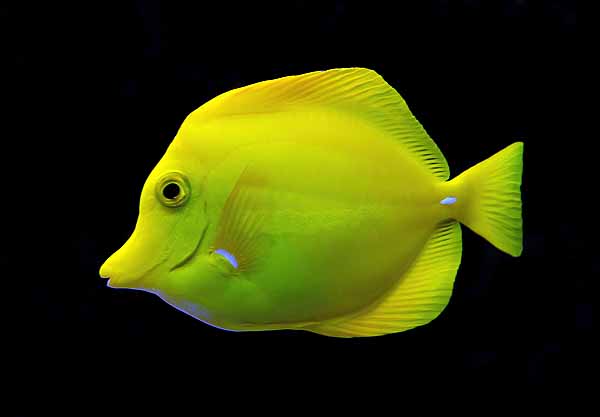
What are some Yellow tang quick facts
- Common Names: Yellow tang, Lemon surgeonfish, Hawaiian tang
- Scientific Name: Zebrasoma flavescens
- Size: ~8 inches (20-21 cm)
- Minimum Tank Size: 90 gallons + (341L)
- Reef-Safe? Yes
- Care or Experience Level: Easy/appropriate for all levels of experience
- Preferred Diet: Algae-eater; Will eat meaty foods if offered
- Captive-Bred Available? Technically, yes, and becoming more readily available
- Original Part of the World: Hawaiian and Pacific Ocean reefs

What is the ideal tank size for a Yellow tang?
The Yellow Tang, Zebrasoma flavescens, will be most healthy in a tank size of 100 gallons (378.5 liters) or more. A tank of this size provides the 8-inch long adult fish enough room to swim and forage on the aquarium rocks and glass for algae films. Smaller tanks may lead to aggression, stress, and susceptibility to disease.
Natural Habitat of the Yellow Tang
Yellow tangs live in subtropical waters from the western coast of Hawaii to the eastern coast of Japan. Their main population is found in Hawaii, where they have the honor as the only solid yellow fish spotted out on the reefs. This is probably why their Hawaiian name – lau’ipala – means “yellowed ti leaf.” (In case you wondered, “flav” is yellow in Latin, so their scientific name plays up that brilliant shade, too)
Most wild-caught yellow tangs come from the Kona Region of Hawaii (the west coast of the Big Island, if you aren’t familiar with the region). They inhabit coral reefs and shallow waters near the continental shelf, hanging out in small schools. They live lower in the water column (down to 100 feet/30m), where the water is calmer.
Juvenile yellow tangs tend to live deeper and farther from the reefs, where it’s safer for them to grow and develop. This is due to their CLEAR larval stage (you got it – another color change). As part of the plankton, they hang out in the deepest part of the oceans. They don’t shift closer to shallower coral reefs until they mature into adults.
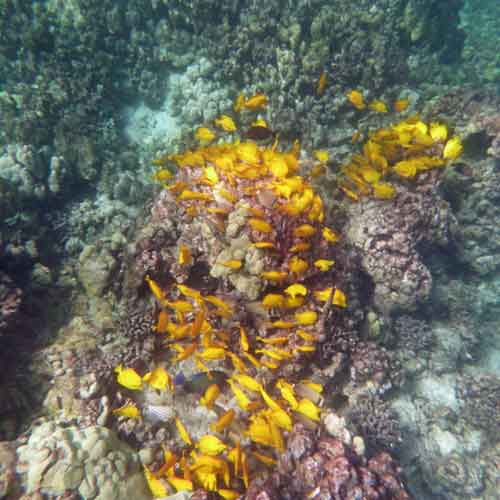
As you can see in the image above, I was fortunate to see shoals of yellow tang off the coast of the Big Island of Hawaii during a dive. They’re one of the smallest of the surgeonfish, and the shoals provide additional defense for them. At night, they’ll divide and find their own crevices to hide in for the night.
Yellow tangs have historically been Hawaii’s largest fish export. They made up 80% of all fish caught for the aquarium trade. In 1990, Fish Replenishment Areas were set up off the Kona Coast, preventing fish collection for aquarium sales in 30% of the area.

Currently, the yellow tang population is listed as stable with no shortage of specimens in the areas where collection is allowed. The yellow tang will likely remain one of the most popular saltwater fish, as long as legislation allows.
Yellow Tang Tank Size
Yellow tangs constantly swim and graze on the surfaces in your tank. It’s recommended to keep them, and pretty much any other types of tangs, in a tank with at least 90 gallons (341L) to allow them sufficient room to swim and find new sources of algae. Within that pointed “nose,” they have flexible comb-teeth. This allows them to pry seaweed and algae from live rock and corals. In the wild, their grazing habits prevent the greenery from outcompeting corals for space on the reef. And it’s a job they engage in ALL DAY.
Yellow tangs often arrive at pet stores small (sometimes 2 inches/5cm or smaller). But it’s important to keep in mind that these tiny rays of sunshine will grow to be 8-inch (20cm) fish darting around. They need LOTS of room to move around. So rather than worrying about upgrading to a new tank down the road, start with an aquarium they can happily grow into.
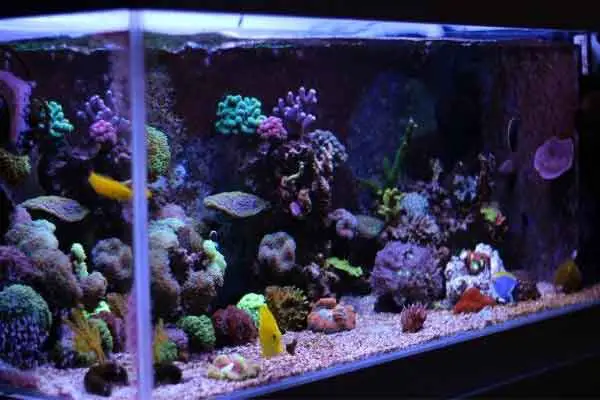
Yellow tangs are bold and active fish that will remain visible in your tank during the day, ducking into a crevice to sleep at night. You’ll notice them in the upper portions of the tank during their active periods, but they’ll need rocks and coral at the bottom of the tank. The structures provide their food sources, as well as hiding places. While they have big personalities, they ARE on the menu for plenty of larger, more aggressive fish. So you want to have plenty of room for ALL of your yellow tang’s needs.
Determining the minimum appropriate tank size for yellow tangs is one of the larger controversies in the hobby. Some sources recommend at least 6 feet (1.8m) of linear open space for your tangs to swim in. You’ll find plenty of chat forums that seem to have groups of yellow tang vigilantes who have made it their mission to protect tangs from tanks that are too small. To stay safe on the forums and avoid getting shamed, don’t keep tangs in tanks under 90 gallons (341L). And make sure they have lots of free space to swim in the open!
You can easily set up an aquarium that combines their needs beautifully. And since the yellow tang doesn’t have any specific water quality needs, all you need to do is maintain stable levels of the key water parameters and use a high-quality salt mix.
Yellow tang compatibility
Yellow tangs are popular community fishes, even though they have a “semi-aggressive” temperament. Generally speaking, they can and will get along with most other community saltwater aquarium fish. Although you SHOULD expect some squabbling over territories and food. Algae isn’t always in plentiful supply. And while yellow tangs order from the herbivore side of the menu, they ARE surgeonfish. That means they’re not above flaring those spines to clear off the competition.

As with any fish with a mean streak, you need to consider the ORDER you add them to the tank. Any fish added after the yellow tang are more likely to receive the brunt of that aggressive streak – minor as it usually is (by reputation, anyway). As such, always make these tangs LAST in. This way, they can’t set up a territory in advance. Then you’ll have a well-behaved ray of sunshine (as opposed to a yellow beam of terror).
Yellow tangs display aggression by flaring their fins and swimming sideways or backward toward the target fish (as you can see in the image below). This shows off their size (what there is of it) and flexes the sharp white scalpel near their tail. Sometimes the display is a non-violent threat, providing enough warning for the target fish to head out of the area. Other times, they give the rival a whack with their scalpel. And it CAN inflict a serious wound.
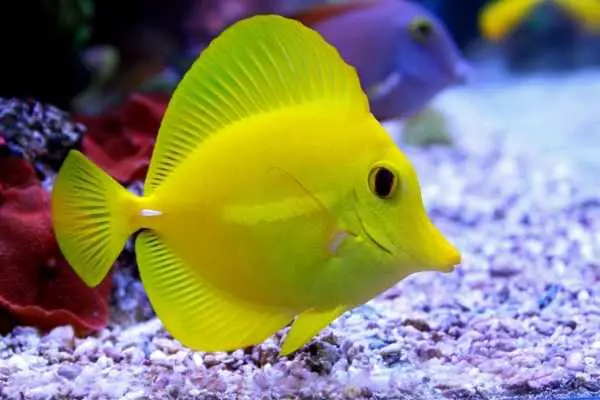
In my experience with yellow tangs (and I’ve had a few over the years), they get along most of the time with almost all other fish. But occasionally, you get that ONE fish your tang just can’t stand for some reason (who can figure out fish brains?). Then they may chase, harass, bully and even slash (I said it – slash!) the other fish.

Generally, it ISN’T recommended to have more than one surgeonfish in an aquarium – and that goes for yellow tangs, too. There are many reports from people successfully keeping three or more, but it requires special planning to avoid problems. If you plan to introduce more than one surgeonfish (of any variety) into your tank, it’s best to add them all at the same time. And start them as juveniles. That way, no fish gets the chance to establish the tank as “theirs” before anyone else. They can then establish a pecking order naturally and (sometimes) peacefully coexist.
Don’t bank on it working perfectly every time, though. It CAN end badly. Just take a look at that image above. (Sad)
Luckily, yellow tangs are reef compatible and will (for the most part) won’t nip at the fleshy polyps of corals. Still, some bold individuals may harm corals by disturbing them too often due to aggressive feeding. To clarify (before you panic), the tangs are eating algae – NOT the corals. But they sometimes upset the apple cart in their zest for their vegan meal.
You should also think twice about keeping them with other aggressive predator fish species, like the ribbon eel or snowflake eel.

Feeding Yellow tangs
With their beak-like snouts and narrow faces, yellow tangs were built to eat algae out of coral crevices and between rocks. And their daily routine is built around grazing and eating all day long. That’s why you see them swimming around your tank, poking around for their preferred meals. With all of the space you’ve provided, you also need to make sure they have access to LOTS of algae.

On coral reefs, yellow tang diets consist primarily of microalgae and macroalgae, depending on what’s available. However, it’s thought that they skew more heavily towards microalgae (Michael 2015). However – like you or I – their diet depends on what’s around. Yellow tangs eat brown, red, green, and even blue-green algae (Michael 2015). In terms of macroalgae, yellow tangs eat filamentous, blue-green, brown, green, and red algae. The digestion of tough cell-wall-rich foods gets assisted by symbiotic protozoans living in their digestive tracts (Michael 2015). (Remember that the next time you’re tempted to dose an antibiotic in your tank)
And if you want an interesting dietary fact and trivia word? In addition to being herbivorous, yellow tangs also consume coprophagous substances. This means (giggle) fish poop officially features in their diet (Michael 2015).
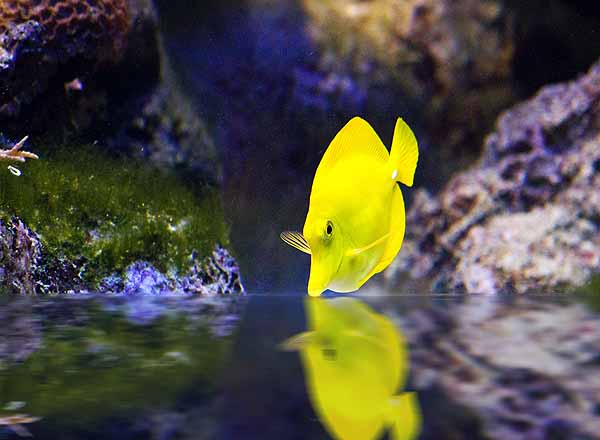
Since yellow tangs are naturally herbivores, they’ll gladly snack on nori and other seaweed-based food options. To give them the most natural access to this food source, distribute it around the tank and tuck it under rocks to create opportunities for them to find it as they graze. The tangs in my tank also tend to eat spirulina flakes.
Even though their preferred/natural food is plant-based, that won’t stop yellow tangs from eating meat-based foods. My tangs greedily ate mysid shrimp, blackworms, and brine shrimp. To keep them happy and healthy, you should feed them at least three times a week. Most people try to feed them daily, though. This keeps their active metabolism happy. And since NO tank ever provides enough algae? That supplementation with extra foods will keep your yellow tangs healthy.
Breeding Yellow Tangs
Yellow tangs – like most surgeonfish – are broadcast spawners. They gather in groups where the females release their eggs, and the males release sperm into the open water. The eggs drift in the plankton before hatching into that clear larval stage. Attempting to duplicate the behavior in captivity never happened for hobbyists. First, trying to get yellow tangs to play nicely together in an aquarium wasn’t always a success. And second, because trying to replicate that kind of reproductive strategy was almost impossible – until 2016.
One of the greatest breakthroughs in aquarium husbandry over the past decade occurred when the Oceanic Institute announced they had successfully cultured yellow tangs. This shattered the previously impossible task of rearing the broadcast spawner in an aquarium setting. This was a monumental task because yellow tang larvae are so small when the eggs hatch and require delicate care and feeding. The Oceanic Institute managed to produce tens of thousands of eggs daily (Callan 2016).
As a result, a limited number of aquacultured yellow tangs are now available in the market. I expect their availability to grow over time. There have even been recent publications about optimizations made to the rearing and larval raising techniques to help.
Common Diseases of Yellow Tangs
Yellow tangs are susceptible to ich and other parasites. A quick scan of hobby forums will turn up plenty of examples of parasites attached to people’s beloved yellow fish. It’s startling how many example pictures of diseased fish are actually yellow tangs.
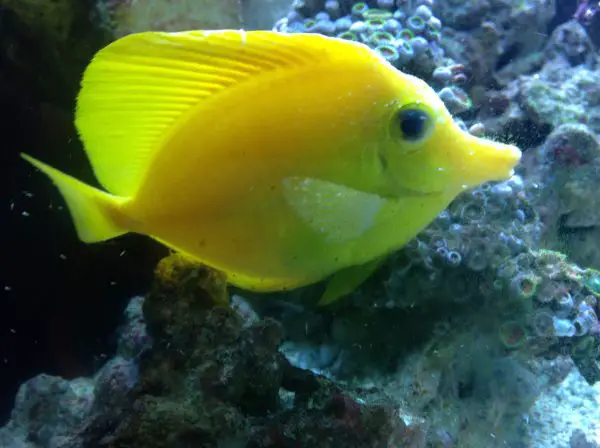
A quarantine tank is necessary for ANY hobbyist. But it seems more important if you plan to bring yellow tangs into your display tank. You MUST quarantine them before introducing them to your community. And perform a thorough examination every day for ANYTHING out of the ordinary. While captive-bred tangs are now available, the majority still seem to come from the wild. And they usually come diseased. For whatever reason, they seem to be parasite magnets. They’ll pick up problems along the way, and the last thing you want is to deliver an infestation into your tank.
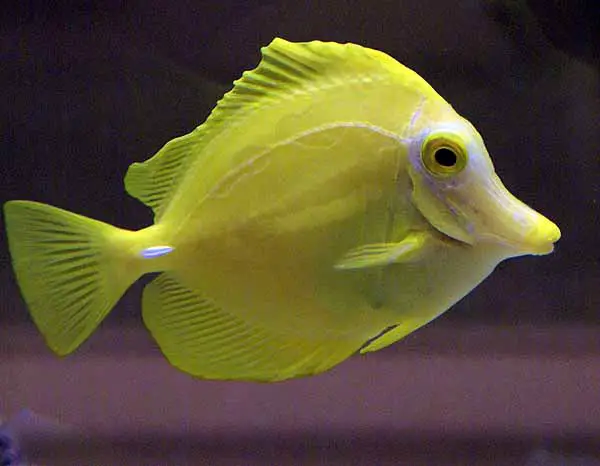
Yellow Tang Ich
If you have a reef tank with fish and invertebrates (corals, clams, shrimps, crabs, etc.) and notice the characteristic white spots of a marine ich infection, you have your work cut out for you.
It’s complicated to rid a tank of ich once it shows up. This is mainly because the things you normally use to kill ich will kill the inverts in your tank. And while it may surprise you, I recommend you skip the “reef-safe remedies” entirely. Instead, you need a two-pronged approach:
- Remove the yellow tang with ich and every other fish to a separate hospital tank with NO invertebrates in it.
- Treat those fish with hyposalinity.
- Allow your reef tank to go “fallow.” This means keeping everything running without the fish for a long period to allow the ich to die off.
Purchasing Yellow Tangs
If you are interested in adding a yellow tang to your tank, online stores will ship them via overnight delivery straight to your door. You can also head to your local fish store. Either way, you’ll want to follow proper acclimation and quarantine procedures to give your new purchase the best chance of survival. Ensure you have access to any live arrival guarantees, too. After all, those parasites can wreak plenty of havoc during shipping (and I don’t mean on the trip to your house).
For More Information
Yellow tangs bring some of the brightest colors and activity to a reef tank. The yellow tang is reef-safe and can be kept with LPS, SPS, soft corals, mushroom corals, and zoanthids. And they don’t require as much space or aggression management as other surgeonfish. So why wouldn’t you want to learn more about them?
Let’s start with this handy YouTube video on yellow tang care:
Or how about this YouTube video about the top tangs out there (in case you’re not sure about this sunny disposition):
Looking for a few great options to keep with a yellow tang? How about these top choices:
Or maybe you’re looking for an alternative to the yellow tang? How about these other members of the surgeonfish group:
Or even these other yellow fish:
Conclusion
If you haven’t already considered adding a yellow tang to your reef aquarium, you should. They’ve been an enjoyable and vibrant part of my tank for most of the years I’ve kept them.

Why do I love them so much?
- They are gorgeous
- Lively, active, and hardy natures
- They get along well with most tankmates
- Grow reasonably fast
- They’re easy to care for
- Only slow down at night
There is no shortage of reasons why the yellow tang is one of the most common fish in hobby aquariums. But keep in mind, while they ARE easy to care for, they have some special considerations. They’re susceptible to disease, prone to aggression in some cases, and can sometimes cause problems for certain types of coral due to their feeding habits.
If treated properly, though, the yellow tang will add color and character to your display tank for many years to come (they can live as long as 10 years!).
Have any questions about caring for the yellow tang? If so, please ask in the comments below.

References
- Callan, Chatham K. “Striking Gold: The Dream of Breeding Zebrasoma flavesens Comes True in a Hawaii Marine Lab.” Coral: The Reef & Marine Magazine. Volume 13: Issue 1 Jan/Feb 2016.
- Michael, Scott W. ” Fishy Grazers on the Reef and in the Aquarium.” Coral: The Reef & Marine Magazine. Volume 12: Issue 4 Jul/Aug 2015
- , . Effects of photoperiod, light intensity, turbidity, and prey density on feed incidence and survival in first feeding yellow tang (Zebrasoma flavescens)(Bennett). Aquac Res. 2018; 49: 890– 899.

Leave a Reply